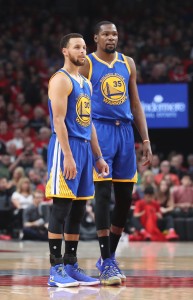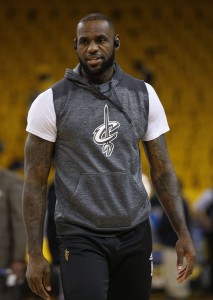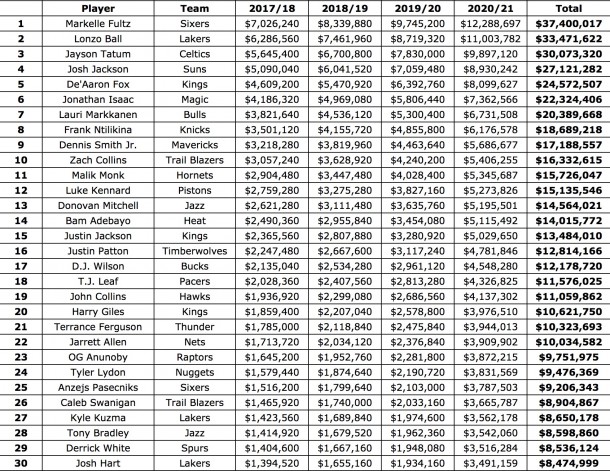Coming off their third consecutive appearance in the NBA Finals, the Cavaliers are in a very unusual spot. Cleveland went 12-1 against Eastern Conference foes in the playoffs, asserting its dominance in the conference once again, but there’s still a sense that the team has to shake things up and make major moves this offseason in order to be able to truly compete with the Warriors.
Heading into the 2017 free agent period though, Griffin is no longer making the team’s basketball decisions, having been unable to reach a new deal with owner Dan Gilbert. Senior VP Trent Redden is out as well, leaving assistant GM Koby Altman and perhaps Gilbert himself as the ones reportedly burning up the phone lines in search of a blockbuster trade.
Not every one of Griffin’s decisions as GM was optimal, and the Cavs are in a tough spot with the salary cap heading into 2017/18. But he’s a smart guy who was intimately familiar with the Cavs’ roster and knew what sort of moves were possible. It’s not clear yet if the same can be said for Chauncey Billups, who is reportedly the frontrunner to become the club’s new president of basketball operations.
Billups has no front office experience, and would likely need to be paired with an experienced executive who could step into the GM role. It’s possible that could work in the long-term, but the fact that it remains up in the air at this point in the summer – Billups is reportedly still considering an offer from Cleveland – isn’t a great sign.
2. How can the Cavaliers add an impact player in a trade?
The Cavs’ ideal scenario would be to add a fourth impact player to their core of James, Kevin Love, and Kyrie Irving, using complementary pieces in a trade. That’s a nice thought, but probably an unrealistic one.
Beyond their three stars, the Cavs’ top contracts include Thompson ($16.4MM in 2017/18), Smith ($13.76MM), Iman Shumpert ($10.34MM), and Channing Frye ($7.42MM). Outside of Frye’s deal, those contracts all have multiple years left on them, and they’re not exactly bargains. Thompson, Smith, and Shumpert are all effective players when they’re playing well, but they’ve has consistency issues. And at those prices, teams might be better off just signing a free agent instead.
The Cavs will still look to include those guys – particularly Shumpert and Frye – in potential trades, but if they want to make a major move, their most logical trade candidate is Love. The former Timberwolf looked more at home in Cleveland in 2016/17 than he had during his first couple years with the team, but he’s the most expendable piece of the Cavs’ “big three,” especially if he could be turned into a top-tier, two-way player like Paul George.
There have been no indications that the rebuilding Pacers want to acquire a pricey veteran like Love, which is why we heard so many rumors last week about the Cavs exploring a potential three-way deal. In such a scenario, Love would be sent to that third team, which in turn would send young players and/or picks to Indiana. It’s an interesting idea, and I believe George would make the Cavs a more versatile and more dangerous team. At this point though, it doesn’t seem like there’s a ton of traction on that front.
3. If the Cavs trade one of their big three, will it definitely be Love and not Irving?
It certainly looks that way. Sam Amico of Amico Hoops reported on Thursday that the Pacers and Bulls tried to insist on Irving rather than Love in a possible deal for George or Jimmy Butler, at which point the Cavs “quickly lost interest.” It’s hard to blame them for that.
All indications are that the Cavs view Irving as a cornerstone piece who can become the team’s franchise player as LeBron enters the tail end of his career. For Cleveland to consider moving its standout point guard, it would have to be a deal for a star who meets that same criteria, and there simply aren’t that many possible franchise players out there. Ones who are as young as Irving (25) and on favorable long-term contracts are even rarer.
4. Will the Cavs be able to use free agency to add any useful pieces?
One advantage of being a perennial title contender is that the Cavs may have a chance to sign solid free agents at a reduced rate. While that has been more common for teams like the Spurs and Warriors in the last couple years (we see you, David West), there may be productive free agents willing to sign on with the Cavs for the minimum to pursue a potential title.
Unfortunately for Cleveland, the club won’t have much more than the minimum to use on free agents this summer. Assuming they don’t shed salary to get out of tax territory, which would be a long shot, the Cavs will lose their full mid-level exception and their bi-annual exception, as well as their ability to acquire a free agent via sign-and-trade, leaving them with the taxpayer mid-level exception. That MLE will be worth $5.192MM and can be used to sign contracts up to three years.
That’s a useful little piece, and should be enough to add a solid rotation player, but there’s no guarantee that team ownership is prepared to use it. With the Cavaliers poised to face repeater tax penalties in 2017/18, a $5.192MM contract would cost the club exponentially more in taxes — the exact amount depends on how far over the tax the Cavs are, but repeater penalties start at $2.50 per dollar spent over the tax, and only increase from there. If the Cavs intend to use that MLE, they’ll have to be very confident that the player they’re signing is worth it, because he’ll be extremely expensive.
5. Is it time to start worrying about LeBron’s long-term future in Cleveland?
In the wake of the Cavs’ Finals loss, rumblings about James possibly bolting Cleveland again in 2018 have grown louder. And it’s not just idle speculation from pundits — reliable reporters like Adrian Wojnarowski of The Vertical have said the Cavs aren’t just assuming LeBron will remain in Cleveland beyond his current deal, and that a move to an L.A. team is “very much in play.”
It may be time for the Cavs to start worrying, but it’s not time for them to start panicking. Forcing win-now moves to appease LeBron could backfire, as they did during his first stint in Cleveland. By the time James left the Cavs in 2010, the team’s roster was stocked with overpaid, underperforming veterans, leaving little flexibility to acquire real help.
While it may seem like the Cavs are nearing that territory this time around too, Irving and Love are far more effective than any player on the 2009/10 roster was, and none of the team’s current contracts is nearly as bad as Shaquille O’Neal‘s (a 38-year-old Shaq earned $20MM in ’09/10, when the cap was $57.7MM).
Still, it won’t be easy for the Cavs to strike the right balance this offseason — their goal is to add immediate help to give LeBron a chance to knock off the Warriors next summer, without taking on the sort of long-term commitments that will compromise their ability to be flexible in two or three years. And, oh yeah, Gilbert probably wouldn’t mind reducing his tax bill a little going forward.
Good luck to the next Cavs’ next head of basketball operations, who figures to have one of the toughest jobs in the NBA.
Here’s where things currently stand for the Cavaliers financially:
Guaranteed Salary
- LeBron James ($33,285,709)
- Kevin Love ($22,642,350)
- Kyrie Irving ($18,868,626)
- Tristan Thompson ($16,400,000)
- J.R. Smith ($13,760,000)
- Iman Shumpert ($10,337,079)
- Channing Frye ($7,420,912)
- Richard Jefferson ($2,500,000)
- Kay Felder ($456,529) — Partial guarantee. Non-guaranteed portion noted below.1
- Total: $125,671,205
Player Options
Team Options
Non-Guaranteed Salary
- Edy Tavares ($1,471,382)
- Kay Felder ($856,082) — Partial guarantee. Guaranteed portion noted above.1
- Total: $2,327,464
Restricted Free Agents
Cap Holds
- Kyle Korver ($9,954,930)
- Dahntay Jones ($1,471,382)
- James Jones ($1,471,382)
- Deron Williams ($1,471,382)
- Derrick Williams ($1,471,382)
- Total: $15,840,458
Trade Exceptions
Projected Salary Cap: $99,000,000
Maximum Cap Room: –$29,933,665
- The Cavaliers’ eight guaranteed contracts, plus four cap charges for empty roster spots, bring the total team salary to $128,933,665. Considering the luxury tax line is currently projected to be around $119MM, the Cavs have virtually no way to get below the cap this summer unless they gut their roster, and will likely end up well into the tax again.
Footnotes:
- Felder’s salary won’t become fully guaranteed until January 10.
Salary information from Basketball Insiders and The Vertical was used in the creation of this post. Photo courtesy of USA Today Sports Images.


